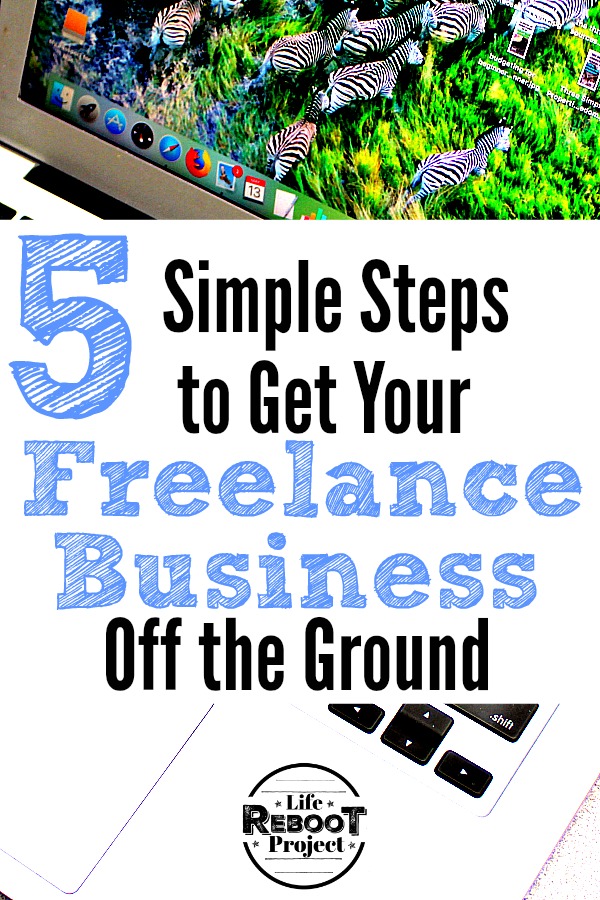
One of the easiest ways to transition away from the working world is to be a freelancer until you get enough passive income streams to support your monthly bills.
For many people, this may be doing the same work they were doing for an employer, just doing it from your home for multiple clients.
When I transitioned away from the working world, I chose freelance writing to be one of my income streams.
I had done freelance writing as a side hustle, but when I left my job, I had to kick it into high gear.
Here is a list of the five steps you will need to consider to get a successful freelancing career off the ground.
The steps will vary slightly depending on what type of freelancing you want to do, but this should give a good head start to finding some clients.
If you are interested in freelance writing like I was, check out Peter Bowerman at the Well Fed Writer.
I have several of his books, and his system is a great way to avoid the low-wage content writing mills commonly found online.
He offers a bunch of books, but I would start with his essential book, “The Well-Fed Writer.”
You can get it directly from him at The Well-Fed Writer.
Then, you can move on from there.
What niche is right for your freelancing business?
One of the first things you will need to do is figure out what niche you want to serve. Serving a particular niche and working for certain types of clients will make it easy on you and it will be an easy way to make the most money.
So, I’m told.
The problem is, if you are new to the world of freelancing, you may not know what area you will want to specialize in.
This was me.
I knew I wanted to do freelance web writing, but the market was so large, I didn’t know what I wanted to do.
So, I did a bunch of stuff.
And, I’m still doing a bunch of different types of writing to try and settle on a niche.
My list is getting narrower, but I still like breaking up the monotony by doing several different types of projects.
I know when I start branding myself as the go-to person in a particular niche, I can probably start getting more money for that particular writing.
But for now, I’m going to keep searching.
Do you have a portfolio ready for your freelancing business?
A portfolio will be vastly different depending on the type of freelance business you are starting.
You will need something to show people. If you are doing design work, you might have some stuff you did as a side hustler you can put into an online or even a physical album.
Wait, we need to back up a bit.
I always recommend people start a blog first. If you are a designer, you probably don’t need to write tirelessly long blog posts. All you will need is a portfolio section, A bio/resume section, and a contact form or a way to get a hold of you.
Something I see becoming popular is to build an email list of potential clients. This is an excellent way to keep in touch with clients and keep you at the front of their minds when projects come up.
The blog will be the place where you can flex your muscles and show off your best writing.
I have several places around the web I point to clients, but my largest one is the blog you are reading now.
I have another website, which is in desperate need of a rebuild when I get the time, where I do have some more portfolio clips. My system is working right now, so a redesign isn’t on my ‘hot’ list.
I know though, I will need to freshen it up sooner than later.
For a writer’s blog, have some examples of stuff you’ve done that aligns with the market in which you are aiming.
If you want to do website content writing, make sure that your website content shines. If you’re going to do email list curation and email writing, give examples of how you’ve done work like that before.
I like case studies.
Businesses want to know how you’ve helped other companies. When you finish a project, write a case study about it.
Illustrate how you helped that business. Take your reader from the client’s struggle through the solution you provided and how they benefitted from your work.
Get testimonials.
There is a better way to sell yourself as a practitioner than to have someone endorse what you do.
I always like to get their approval to use it in your marketing if they do give you a testimonial.
Anyway, you can avoid possible future headaches the better.
Where do your potential customers hang out?
Finding clients is one of the biggest hurdles you will need to cross when you leave your job.
If you were a designer or writer at a job, you were assigned projects or just had an automatic stream of work coming in your door.
Now that you are going to be a freelancer, you will need to be the marketing department, and the sales department all rolled into one.
For some people, this will be extremely tough.
I’m an introvert. The thought of cold calling makes me cringe. I do the consultation over the phone, but this is for only warm leads.
I find cold calling excruciatingly painful.
To have a successful marketing campaign, you will need to drop the fish hook where your clients are swimming.
This is also why it is better to start freelancing in the general market in which you worked.
You may know your customer. You may know by doing the campaigns how they think and where to find them.
Using Manta and the library.
Here are a couple of great resources to use to help you with your research.
The first is Manta. Manta has a whole ton of information about businesses. By using LinkedIn and Manta together, you can get a whole bunch of information about any particular company.
You’ll want to pinpoint your marketing to the ideal person in the company. This is where the combination of Manta and LinkedIn is useful. You can find a ton of contact information in any company.
My other favorite resource for finding company information is located at our local library or at least through my local library.
Many libraries offer access to a bunch of online databases where you can find information and listings for all sorts of niche businesses.
All you need to do is get your library card and start building your contact list.
Social media is another place to start cultivating leads. I don’t do it, but for only a couple of dollars a day, you could run a Facebook ad and target it specifically to the type of customer you’re looking for.
Setting your freelancing terms and figuring out how you are going to get paid
If you are jumping into the freelancing world for the first time, there are some excellent resources and some bad advice out there. Besides the help, I got from Peter Bowerman at the Well Fed Writer, the other most reliable source for information I found is Carol Tice at Make a Living Writing.
She has a bunch of free information online as well as several books which deal with the specifics of writing as a business.
You can get it from her site at Make a Living Writing.
But, I’ll give you some basic stuff you will need to set up.
First, you will need a way to get paid. I use PayPal.
They do take a percentage, but they are the standard of the industry, and it is super easy to set up an account.
I think if you get regular clients or larger projects, EFTs directly through your bank might be feasible, but to start, I think PayPal is the way to go.
The next thing I will advise you on, as well as Carol Tice and Peter Bowerman, is you will need to get a contract.
I’ve done some projects without one and haven’t gotten burned, luckily. The best bet is to get a contract spelled out with who owns the rights to the completed work, payment terms, time of deliverability, and several revisions.
While we are on the subject, I always get a 50% down payment. If the project is more of an hourly deal, estimate the number of hours and get some cash in your hand.
This will separate the serious customers from what I call ‘Tire Kickers.’ ‘Tire Kickers’ is a term used around auto dealerships to describe people who aren’t serious shoppers.
Getting some money in your hand will tell you these people are at least serious enough not to waste your time.
Carol Tice and Peter Bowerman have whole chapters in their books and entire articles on their sites dealing with the business of writing. These are the resources I used to learn the ropes.
Jump in, get your feet wet, and start finding clients.
The best advice I can give is to jump in and start doing.
You will more than likely make mistakes in the beginning. But, the biggest hurdle you are going to cross is just starting.
Learning as you go.
Zig Ziglar used to have a saying of ‘getting cooked in the squat.’
I think the story goes; that his wife used to bake the best biscuits.
You need to let the biscuits rise, so you get the perfect biscuit.
If the biscuits wait too long to rise, they will get cooked in the squat.
You need to start your freelance writing business and fix the problems along the way to never get caught in the ‘planning stage’ and never do.
Don’t get cooked in the squat.
Freelancing is a great way to earn money when leaving your current job or even as a side hustle while still working a job.
I’ve done the freelancing side hustle while in my job. Now I’m transitioning to doing it as a full-time freelancer as I build my passive income streams.
The biggest obstacle you are going to face is just getting started.
Till next time, be safe.
Kevin

